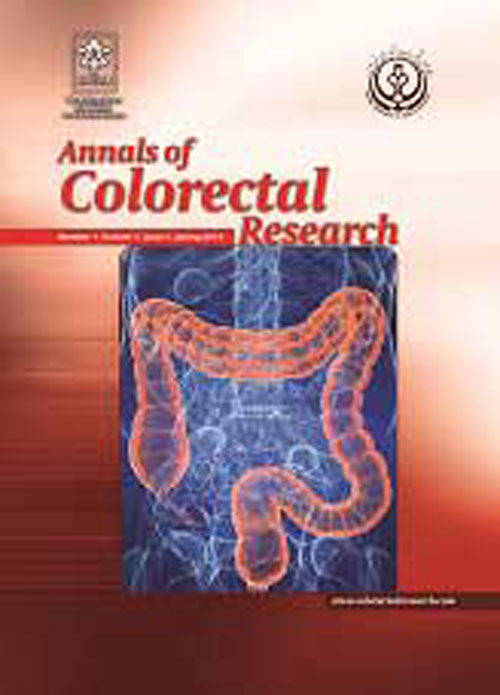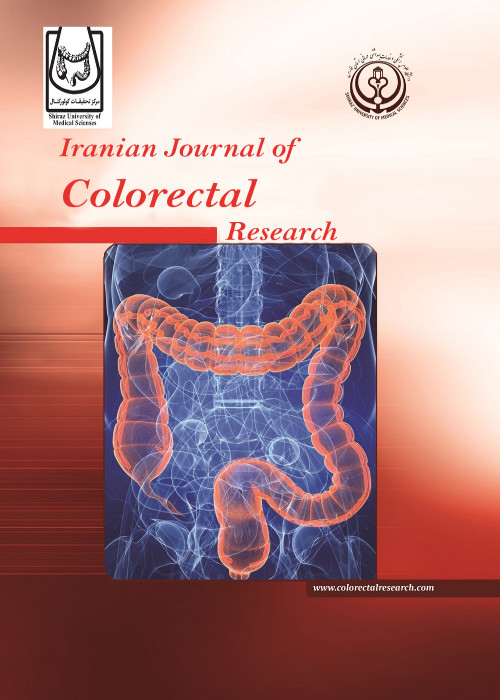فهرست مطالب

Iranian Journal of Colorectal Research
Volume:8 Issue: 1, Mar 2020
- تاریخ انتشار: 1398/12/11
- تعداد عناوین: 8
-
-
Pages 1-8
BACKGROUND AND AIMS Previous small to mid-sized studies have found an inconsistent relationship between diverticulosis and colon polyps. We assessed the odds of polyps in patients with left-sided diverticulosis (LDV) compared to patients without LDV, and if a predilection for polyps in the distal colon (DC) versus the proximal colon (PC) existed. METHODS In this case-control, retrospective study records of all patients in the Cleveland Clinic undergoing average-risk, screening colonoscopy between January 2011-August 2017 were identified. Baseline characteristics were described. Multivariate logistic regression analysis was performed to identify odds of polyps in PC and DC after adjusting for clinical and colonoscopic factors. RESULTS 50,703 patients (mean age=60 years; 48% male) were included; 38.9% of patients had LDV. Compared to patients without LDV, those with LDV more often had adenomas (33.2% vs 27.8%; P<0.001), hyperplastic polyps (HPs) (18.3% vs 16.2%; P<0.001), and sessile serrated polyps (SSPs) (4.8% vs 4.3%; P=0.011). LDV was associated with adenomas in the DC (OR, 1.59; 95%CI, 1.52, 1.67) more than the PC (OR, 1.15; 95%CI, 1.10, 1.21), with HPs equally in the PC (OR, 1.27; 95%CI, 1.20, 1.34) and DC (OR, 1.28; 95%CI, 1.19, 1.38), and with SSPs in the DC only (OR, 1.50; 95%CI, 1.34, 1.67). CONCLUSIONS LDV is associated with a significantly increased risk of adenomas, HPs, and SSPs, but the association was stronger for adenomas in the DC. Careful inspection of the DC should be encouraged in patients with LDV. More research is needed to understand this phenomenon.
Keywords: adenomas, colorectal cancer surveillance, sessile serrated polyps, sessile serrated polyps detection rate, adenoma detection rate -
Pages 9-16
1. Context Endoplasmic reticulum stress (ER stess) is associated with endoplasmic reticulum perturbation homeostasis. Prolonged ER stress conditions may induce cell death. Unfolded protein response (UPR) attempts to restore normal cell conditions. 2. Evidence Acquisition There now exists an emergent body of evidence identifying the WNT signaling network as a regulator of cancer cell metabolism. Given that existing findings show that the WNT pathway and ER stress regulates changes in metabolic activities of cancer cells suggesting these signaling pathways represent critical nodes in the regulation of central metabolism in tumors. 3. Results Findings suggest that the molecular cross-talks between hypoxic ER stress, Wnt/βcatenin signaling, may represent an important mechanism that enables some tumor subtypes to survival and grow in hypoxic conditions. 4. Conclusions The present article disuses differential effects of the activation of the three arms of UPR, namely endoplasmic reticulum kinase (PERK), activation transcription factor -6 (ATF-6), and inositol –requiring enzyme (IRE-1) on cancer. This review also highlights regulators and downstream effectors of Wnt cascade and addresses the increasingly apparent crosstalk of Wnt with other tumorigenic signaling pathways.
Keywords: Endoplasmic reticulum, Stress, cancer, UPR, Wnt -
Pages 17-22Background
Zataria multiflora Boiss is a well-known medicinal plant and its’ essential oil (EO) is traditionally used for treatment of respiratory and digestive disorders and/or bacterial, viral, fungal, and parasitic infections.
ObjectiveThis study was undertaken to evaluate the effect of long-term consumption of Z. multiflora EO on hematological and biochemical parameters in patients infected with liver hydatid disease.
Materials and MethodsFifteen patients were administered orally with Z. multiflora EO (60 mg daily) for six months. Hematological and biochemical analysis were performed on the blood samples of patients before the start of treatment and after completion of the treatment course. In hematological analysis, WBC, RBC, Hb, hematocrit, MCV, MCH, MCHC and platelets were measured. In biochemical analysis, FBS, BUN, creatinine, cholesterol, triglycerides, HDL, LDL, Na, K, Cl, AST, ALT, and ALK were assessed.
ResultsNo apparent changes were observed in the values of hematological parameters of the patients after treatment. No significant changes also occurred in the values of FBS, BUN, creatinine, cholesterol, triglycerides, HDL, LDL, Na, and K. The mean values of AST, ALT and ALK enzymes decreased significantly after treatment (P ˂ 0.05). No adverse clinical event was noticed in the patients during the course of study.
ConclusionsLong-term consumption of Z. multiflora EO induced no adverse effect on the hematological and biochemical parameters of patients infected with liver hydatid disease. Since Z. multiflora EO reduced the level of liver transaminases (AST, ALT and ALK), this herbal product may be considered as a hepatoprotective agent in human beings.
Keywords: Zataria multiflora, Essential oil, Hematological parameters, Biochemical parameters, Clinical study -
The effect of various surgical techniques in difficult cholecystectomy: A retrospective cohort studyPages 23-28Background
Success of laparoscopic cholecystectomy depends on multiple factors.Knowledge about altered anatomy, physiology and pathology of gall bladder, and thesurgeons experience in applying different surgical technique during difficult cholecystectomyare collectively important for a safe outcome.
MethodsA total data of 875 patients who underwent cholecystectomy were analysed from June 2014 to May 2019. Study was mainly focused on looking for various intraoperative findings that could be the reason for conversion to open cholecystectomy in patients with difficult anatomy, physiology and pathology associated gall stone disease.
Resultsabout 279/875 (31.9%) had difficult gall bladder with altered anatomy and pathology. Overall, conversion rate among difficult laparoscopic cholecystectomy was 62/279 (22.2%). 36/875 (2.4%) patients undergone subtotal cholecystectomy. 1/875 (0.1%)had common bile duct injury underwent repair. 54/875 (61.7%) had developed overall complications and 1/875 (0.1%) died due sepsis.
ConclusionHigh conversion rate and complications are seen in patients with contracted gallbladder and adhesions due to previous intervention. Conversion from laparoscopic cholecystectomy to open cholecystectomy is not a complication but continuum of treatment to reduce morbidity. Use of the critical view of safety technique very useful.
Keywords: Laparoscopic Cholecystectomy, open, Surgery -
Pages 29-32
Determining the tumor-stroma ratio (TSR) using a conventional microscope is an easy to apply and highly reproducible method. Due to digitalization in the pathology workflow, the demand for automated analysis of the TSR method is rising. However, the process of automation is rather time consuming and needs validation before implementation in daily practice. In addition, international studies ask for exchange of digital images instead of the actual slides. This calls for an alternative digital scoring method. This brief report describes the pitfalls of analyzing the TSR using digital images and proposes essential adaptations to create a standardized and reproducible scoring protocol. By using a circular annotation to mimic the microscopic method, these pitfalls can be avoided. Scoring the TSR digitally using a circular annotation does not take much additional effort compared to the microscopic method. When a fixed size of the annotation is saved, new cases can be scored in less than two minutes. With this brief report we propose an adjusted method for scoring the TSR on digital images to fill the gap between microscopically and automated scoring of the TSR. In addition, it opens the opportunity for application in daily diagnostics.
Keywords: Automation, digital analysis, microscopic analysis, tumor-stroma ratio -
Pages 33-36
There are few reports on the therapeutic role of colonoscopy in correcting intussusception of childhood. In the present report, 15 children (14 boys and 1 girl) presented with acute intussusception and successfully treated by colonoscopy were presented. The patients were referred to the gastroenterology clinic of Ami-Al-Momenin Hospital, Zabol, Iran from 2015 to 2018. The mean age of the patients was 36.6±28.7 months. After stablishing the diagnosis, they underwent colonoscopic reduction of intussusception by an experienced gastroenterologist. Following 24 hours of the procedure, follow up sonography was performed. Overall, 6 recurrences were identified in 4 (26.7%) patients which were managed by a second colonoscopy. A second recurrence was detected in two patients who finally underwent surgical reduction. Regarding the role of colonoscopy in providing a visual and real-time setting, this can be used as either a primary option or an alternative to radiologic and surgical procedures of intussusception reduction in children.
Keywords: Intussusception, Endoscopy, Enema, children -
Pages 37-39
We report a rare variant of mucocele of the appendix. An elderly gentleman was admitted with symptoms and signs of acute appendicitis. He underwent laparoscopic converted open appendicectomy. On exploration there were pearls or fish egg like globular material along with jelly in and around the appendix. On examination of the specimen a differential diagnosis of hydatid cyst or pseudomyxoma was considered. On microscopic examination, the globules consisted of eosinophilic laminations of mucin surrounding an amorphous granular core. After histopathological examination, our case was diagnosed as myxoglobulosis of the appendix.Acute appendicitis is a common clinical problem and appendisectomy a regular surgery. The clinician should be aware of this entity of myxoglobulosis, to avoid confusion with pseudomyxoma or hydatid cyst. Presence of typical fish eggs or pearls like globular structures in and around the appendix is suggestive of myxoglobulosis. Appendisectomy is curative treatment for patients with myxoglobulosis of appendix and there are no reports of its recurrence.
Keywords: Gastrointestinal surgery, General surgery, chronic abdominal pain, acute appendicitis -
Page 40
I review the interesting article “Effects of Platelet-Rich Plasma on Healing of Sphincteroplasty: An Experiment in Rabbit Model” (1)about application of Platelet-Rich Plasma in the anal sphincteroplasty While reviewing the article which proposed a novel idea for improving the outcome of sphincteroplasty three issues were questionable for me: The first issue is the site of sphincterotomy as it is mentioned located in posterior midline. It is known that the external anal sphincter is connected posteriorly to the anococcygeal ligament posteriorly (2) and division of sphincter in this point is not always associated with separation of sphincter and fecal incontinence. Animal experiments on the anal sphincter is different in the basis of sphincter function rather than an anatomical basis has a physiologic basis and if sphincterotomy is done in an animal the impaired function should be demonstrated(3) before further intervention. Due to small size of sphincter complex in the small animals it is sometimes hard to understand the exact territory of muscle.
Keywords: PRP, Rabbit, Sphincteroplasty


